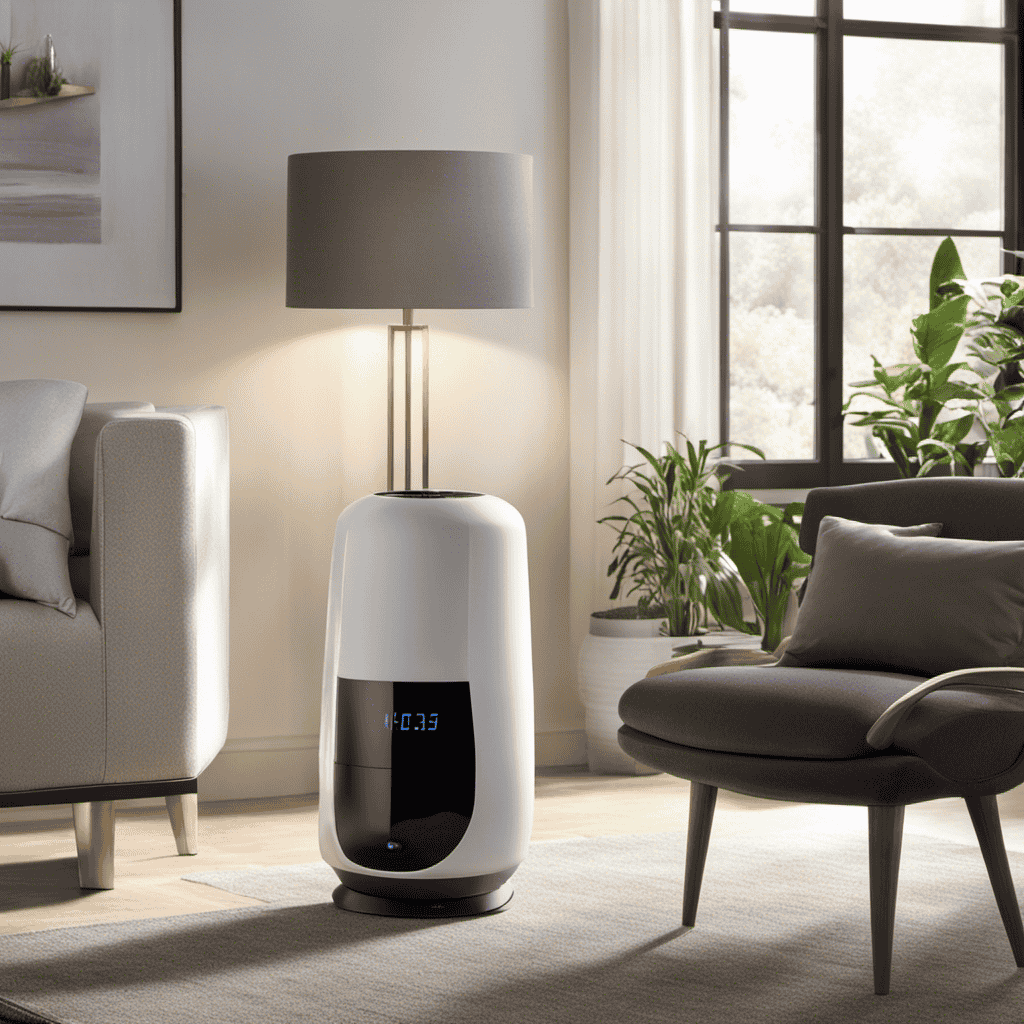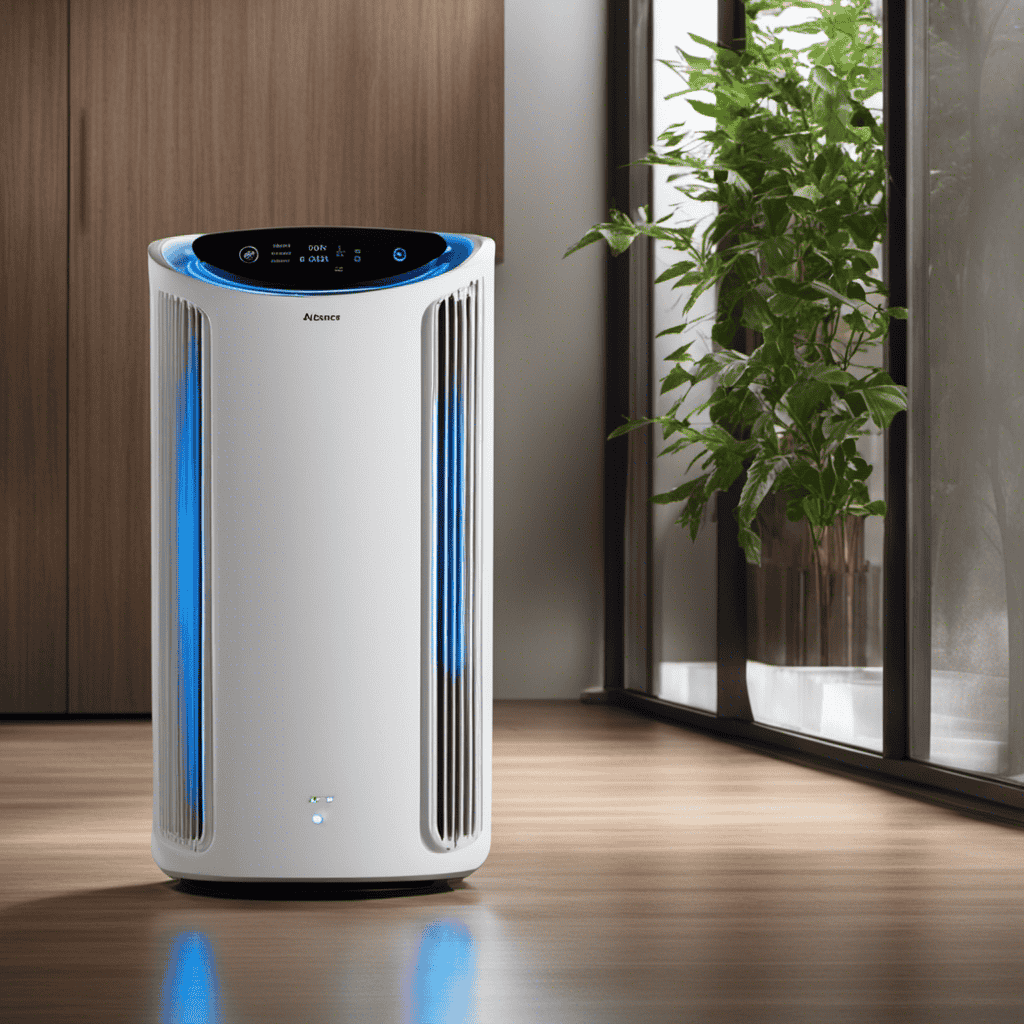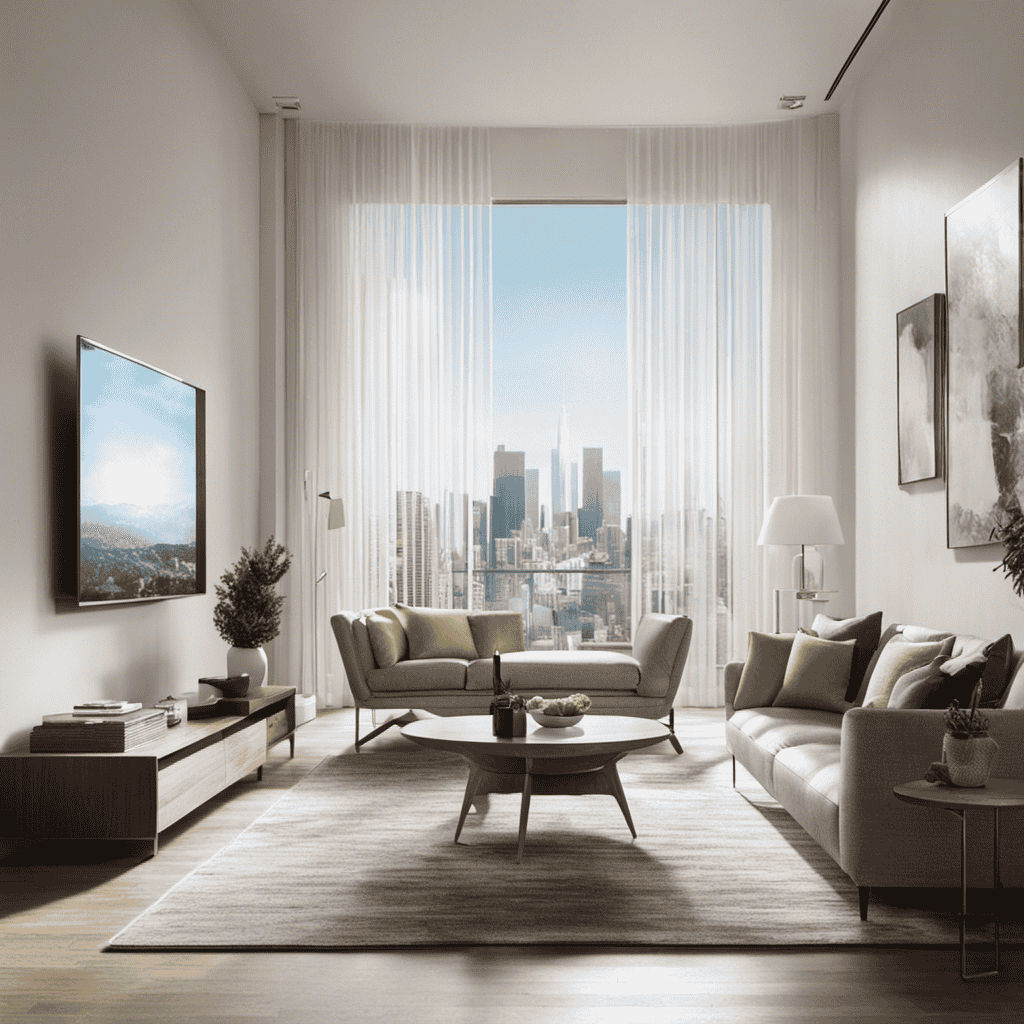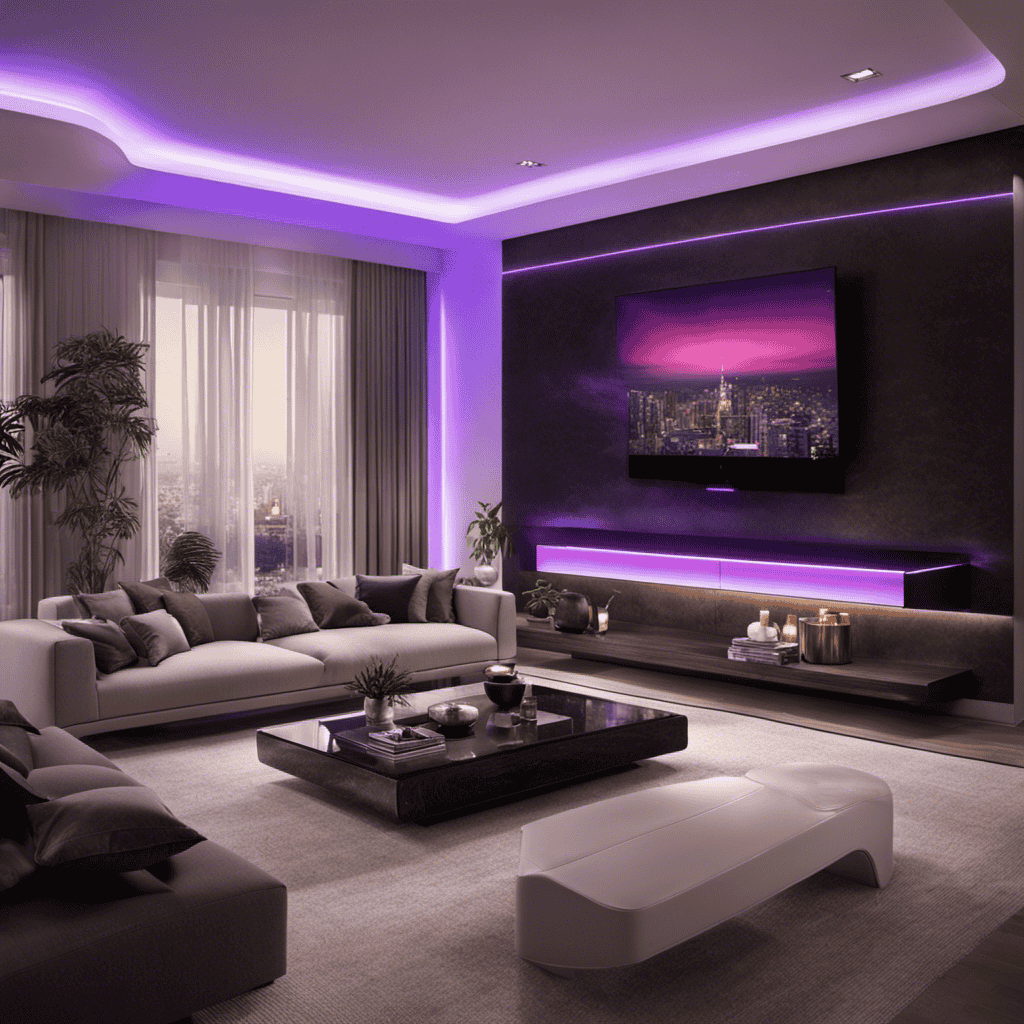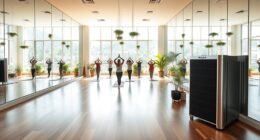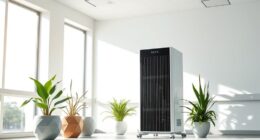I have always been interested in the air quality within my home, particularly considering the presence of pollutants and allergens. This is when I came across the benefits of a negative ion air purifier.
This remarkable device harnesses the power of negative ions to clean and freshen the air we breathe. In this article, we’ll delve into the inner workings of a negative ion air purifier, explore its benefits, and discuss how it compares to other air purification methods.
So, let’s take a deep breath and dive into the world of negative ion air purifiers!
Key Takeaways
- Negative ion air purifiers release negatively charged ions into the air to neutralize positively charged particles.
- They can improve indoor air quality, provide relief from allergies and asthma, enhance mood and sleep, reduce airborne bacteria and viruses, and neutralize common indoor odors.
- When choosing a negative ion air purifier, consider the coverage area, CADR rating, filter replacement requirements, maintenance and cleaning needs, and follow the manufacturer’s instructions for proper usage and safety.
- Safety considerations include ozone production, allergies and sensitivities, regular maintenance, following manufacturer’s instructions, and testing the purifier in a small area for those with allergies or sensitivities.
How Does a Negative Ion Air Purifier Work
A negative ion air purifier works by releasing negatively charged ions into the air to neutralize and eliminate harmful pollutants. This technology, known as negative ion technology, is based on the principle that negative ions have the ability to attach themselves to and neutralize positively charged particles in the air.
The air purification process starts when the air purifier generates negative ions using a high-voltage electric field. These ions are then released into the surrounding air, where they disperse and begin to attract and neutralize pollutants such as dust, pollen, pet dander, and smoke.
As the negative ions attach themselves to these pollutants, they become heavier and fall to the ground or onto nearby surfaces. This process effectively removes the pollutants from the air, making it cleaner and healthier to breathe.
Moreover, negative ions have been shown to have additional benefits for air quality. They can help to reduce the concentration of airborne bacteria and viruses, as well as neutralize common indoor odors.
Benefits of Using a Negative Ion Air Purifier
Using a negative ion air purifier can provide several benefits. These include improved indoor air quality, relief from allergies and asthma, and enhanced mood and sleep.
Negative ions are known to attach to airborne particles, such as dust, pollen, and pet dander. This causes them to become too heavy to remain in the air, thus improving indoor air quality.
For individuals with allergies and asthma, these purifiers can help reduce the presence of allergens and irritants. This leads to symptom relief and a more comfortable living environment.
Additionally, negative ions have been shown to increase serotonin levels in the brain. This can improve mood and promote better sleep, leading to a more positive overall well-being.
Improved Indoor Air Quality
With an improved indoor air quality, you’ll notice a significant difference in the freshness of the air. The benefits of improving the air quality in your home extend far beyond just the smell. Here are three reasons why improving indoor air quality is important:
-
Improving Respiratory Health: Clean air reduces the risk of respiratory issues such as allergies, asthma, and other respiratory diseases. By minimizing airborne contaminants, you can breathe easier and reduce the chances of developing respiratory problems.
-
Reducing Airborne Contaminants: Poor indoor air quality can contain various contaminants like dust, pollen, pet dander, and mold spores. These pollutants can trigger allergies, asthma attacks, and other respiratory symptoms. By improving air quality, you can effectively reduce these airborne contaminants and create a healthier living environment.
-
Enhancing Overall Well-being: Breathing clean air not only improves respiratory health but also contributes to overall well-being. Fresh air can boost energy levels, improve concentration, and promote better sleep. It can also reduce symptoms like fatigue, headaches, and eye irritation caused by poor air quality.
With these benefits in mind, let’s explore how an improved indoor air quality can provide allergy and asthma relief.
Allergy and Asthma Relief
Improving indoor air quality can significantly alleviate symptoms of allergies and asthma. As someone who suffers from allergies, I understand the importance of creating a clean and healthy environment.
Allergies occur when our immune system reacts to substances in the air, such as pollen, dust mites, or pet dander. These triggers can cause symptoms like sneezing, coughing, and wheezing. By taking steps to prevent allergies, we can improve our respiratory health and overall well-being.
One effective way to do this is by using an air purifier that emits negative ions. These negatively charged particles attach themselves to airborne allergens, making them heavier and causing them to fall to the ground or get trapped in the purifier’s filter. This helps to reduce the amount of allergens in the air, providing relief for allergy and asthma sufferers.
Mood and Sleep Enhancement
One effective way to enhance mood and improve sleep is by using a device that emits soothing sounds and aromas. These devices, commonly known as mood and sleep enhancers, have gained popularity in recent years for their ability to create a calming and relaxing environment.
Here are three important benefits of using these devices:
-
Mood Enhancement: The soothing sounds and aromas emitted by these devices have been shown to have a positive impact on mood. They can help reduce stress and anxiety, promote relaxation, and create a sense of tranquility.
-
Improved Sleep Quality: The calming effects of these devices can also aid in improving sleep quality. By creating a peaceful environment, they can help individuals fall asleep faster and enjoy a deeper and more restful sleep.
-
Enhanced Relaxation: In addition to mood enhancement and improved sleep quality, these devices also promote relaxation. The combination of soothing sounds and pleasant aromas can help individuals unwind after a long day and create a peaceful atmosphere conducive to relaxation.
Using a mood and sleep enhancer can greatly contribute to overall well-being and quality of life.
In the following section, we will explore different types of negative ion air purifiers and their benefits.
Types of Negative Ion Air Purifiers
When it comes to choosing the right negative ion air purifier, it’s important to weigh the pros and cons.
Negative ion air purifiers have been shown to effectively remove pollutants and improve air quality, but they may not be suitable for everyone.
Factors such as room size, specific air quality concerns, and personal preferences should be considered before making a decision.
Pros and Cons
If you’re considering a negative ion air purifier, it’s important to weigh the pros and cons. Negative ion air purifiers have become popular due to their ability to improve air quality and potentially provide health benefits. However, they also have some drawbacks that should be considered.
Here are the pros of negative ion air purifiers:
- Improve air quality by removing pollutants and allergens from the air.
- Can help alleviate symptoms of respiratory conditions such as asthma and allergies.
- Create a calming and relaxing environment by increasing serotonin levels.
On the other hand, there are also cons to consider:
- Ozone production: Some negative ion air purifiers can produce ozone, which can be harmful to health in high concentrations.
- Limited coverage: Negative ions have a short range, so the purifier may only be effective in a small area.
- Maintenance: The collection plates or filters in negative ion air purifiers need regular cleaning or replacement to maintain effectiveness.
Considering these pros and cons will help you make an informed decision about whether a negative ion air purifier is the right choice for you.
Choosing the Right One
To choose the right option, consider the features and specifications of different air purifiers. When it comes to air purifiers, there are several key features that you should consider.
First, look for a purifier with a high CADR (Clean Air Delivery Rate), as this indicates its ability to remove airborne pollutants effectively. Additionally, pay attention to the purifier’s coverage area and noise level, as these factors can greatly impact its performance and your comfort.
Another important consideration is the type of filters used in the purifier, as different filters target specific pollutants. Finally, don’t forget to compare the cost of different models, factoring in not only the initial purchase price but also the cost of replacement filters and energy consumption.
Considering these features and cost comparison will help you make an informed decision when choosing an air purifier.
In the subsequent section, we will discuss the factors to consider when choosing a negative ion air purifier.
Factors to Consider When Choosing a Negative Ion Air Purifier
Consider the factors you need to keep in mind when choosing a negative ion air purifier.
When selecting a negative ion air purifier, there are several important features that you should consider:
-
Coverage Area: Determine the size of the area you want to purify. It is crucial to choose a purifier that can handle the square footage of your space effectively. A purifier with insufficient coverage may not be able to effectively remove pollutants from the air.
-
CADR Rating: The Clean Air Delivery Rate (CADR) is a measure of the purifier’s efficiency in removing specific pollutants such as dust, pollen, and smoke. Look for a purifier with high CADR ratings for the pollutants you are most concerned about.
-
Filter Replacement: Check if the purifier requires regular filter replacement. Some models have washable or reusable filters, while others require replacement filters. Consider the cost and availability of replacement filters to ensure long-term usability.
By taking these factors into account, you can make an informed decision when choosing a negative ion air purifier that suits your needs.
Now let’s explore how negative ion air purifiers can improve indoor air quality.
Can Negative Ion Air Purifiers Improve Indoor Air Quality
When it comes to improving indoor air quality, negative ion air purifiers have gained popularity in recent years. These devices work by emitting negative ions into the air, which attach to and neutralize harmful particles such as dust, pollen, pet dander, and mold spores. As a result, these pollutants become too heavy to remain airborne and fall to the ground or are easily captured by the air purifier’s filters.
Studies have shown that negative ions can have several health benefits. Firstly, they can help to improve respiratory conditions such as asthma and allergies by reducing the presence of airborne allergens. Negative ions have also been found to increase the efficiency of the respiratory system, allowing for better oxygen absorption and promoting overall lung health.
Additionally, negative ions may have a positive impact on mental health and well-being. Research suggests that exposure to negative ions can help to reduce stress, improve mood, and enhance overall cognitive function. This is believed to be due to the increased production of serotonin, a neurotransmitter that regulates mood and promotes feelings of happiness.
Are Negative Ion Air Purifiers Safe to Use
Using negative ion air purifiers is generally considered safe, but it’s important to follow the manufacturer’s instructions and avoid prolonged exposure to high levels of negative ions. Negative ion air purifiers work by emitting negatively charged ions into the air, which then attach to positively charged particles like dust, pollen, and pet dander, causing them to become heavy and fall to the ground. This helps improve indoor air quality by reducing the number of airborne pollutants.
However, there are a few potential health risks associated with negative ion air purifiers that should be considered:
-
Ozone production: Some negative ion air purifiers also produce ozone as a byproduct. Ozone is a lung irritant and can worsen respiratory conditions, such as asthma or chronic obstructive pulmonary disease (COPD). It’s important to choose a negative ion air purifier that does not produce ozone or has low ozone emission levels.
-
Allergies and sensitivities: Negative ions can cause allergic reactions or irritations in some individuals. If you have a history of allergies or sensitivities, it’s recommended to test the air purifier in a small area before using it extensively.
-
Maintenance and cleaning: Negative ion air purifiers require regular cleaning and maintenance to ensure their effectiveness. Failure to clean the purifier regularly can lead to the accumulation of pollutants and reduce its performance.
Comparing Negative Ion Air Purifiers to Other Air Purification Methods
In comparing negative ion air purifiers to other air purification methods, it is important to consider factors such as cost and energy efficiency. Let’s take a closer look at how negative ion air purifiers stack up against HEPA filters and activated carbon filters.
| Air Purification Method | Cost | Energy Efficiency |
|---|---|---|
| Negative Ion Air Purifiers | $$ | $$$ |
| HEPA Filters | $$$ | $$ |
| Activated Carbon Filters | $$$ | $$ |
When it comes to cost, negative ion air purifiers tend to be more affordable compared to HEPA filters and activated carbon filters. This can be attributed to their simpler design and lack of replaceable filters. However, it is important to note that negative ion air purifiers may require more frequent cleaning to maintain their effectiveness.
In terms of energy efficiency, negative ion air purifiers are generally more energy-efficient compared to activated carbon filters. This is because negative ion air purifiers do not require fans or motors to operate, whereas activated carbon filters often rely on these components for air circulation.
Do Negative Ion Air Purifiers Remove Allergens and Pollutants
To determine if allergens and pollutants are effectively removed, you may want to consider the effectiveness of negative ion air purifiers. Negative ion air purifiers work by emitting negatively charged ions into the air, which attach to positively charged particles like allergens, dust, and smoke, causing them to become heavy and fall to the ground or get trapped on surfaces.
Here are three key points to consider when evaluating the effectiveness of negative ion air purifiers:
-
Negative ion air purifiers can effectively remove allergens and pollutants from the air, helping to improve indoor air quality and reduce allergy symptoms. Studies have shown that negative ions can effectively remove airborne particles, including pollen, pet dander, and mold spores.
-
Negative ion air purifiers can complement the use of HEPA filters. While HEPA filters are highly effective at capturing particles, negative ions can help to further enhance air purification by neutralizing and removing smaller particles that may escape the filter.
-
Negative ion air purifiers do not produce ozone at harmful levels. While it is true that negative ion air purifiers emit small amounts of ozone, the levels are well below the safety limits set by regulatory agencies. In fact, negative ions can actually help to reduce ozone levels in indoor environments.
Tips for Maintaining and Cleaning a Negative Ion Air Purifier
In my experience with negative ion air purifiers, I have found that regular maintenance and cleaning are crucial for maintaining their efficiency. Neglecting these tasks can result in reduced performance and even the development of common issues.
To ensure optimal functioning, it’s important to clean the ionizer plates regularly. These plates attract and trap airborne particles, so they can become dirty over time. I recommend checking the manufacturer’s instructions for specific cleaning guidelines, as different models may have different requirements. Generally, the plates can be wiped clean with a damp cloth or gently washed with mild soap and water.
Another important aspect of maintenance is replacing the filters when necessary. Most negative ion air purifiers have a pre-filter and a main filter. The pre-filter captures larger particles, while the main filter removes smaller particles and odors. Depending on the model and usage, these filters may need to be replaced every few months. Regularly checking and replacing the filters will ensure that the purifier continues to effectively remove allergens and pollutants from the air.
In addition to maintenance, troubleshooting common issues is also important. If the purifier is not producing negative ions or if its performance has noticeably decreased, it may be helpful to check the power source, the connection between the purifier and the power source, and the overall condition of the unit. It’s also important to consider the environment in which the purifier is placed. If it is placed in an area with high levels of dust or smoke, it may require more frequent cleaning.
Frequently Asked Questions
Can a Negative Ion Air Purifier Help With Respiratory Conditions Such as Asthma or Allergies?
Yes, a negative ion air purifier can help with respiratory conditions such as asthma or allergies. These purifiers work by releasing negative ions into the air. These negative ions attach to harmful particles like dust, pollen, and pet dander, making them heavier. As a result, these particles fall out of the air. This helps improve overall air quality in a home or office, reducing the triggers for respiratory symptoms.
However, it is important to note that some people may be sensitive to high levels of negative ions. Therefore, potential side effects or risks should be considered.
Are Negative Ion Air Purifiers Effective in Removing Cigarette Smoke or Pet Odors?
Negative ion air purifiers have numerous benefits when it comes to removing cigarette smoke or pet odors. These purifiers work by releasing negatively charged ions into the air, which attach to and neutralize harmful particles and odors. They can effectively reduce the presence of these unwanted smells in your home.
However, it is important to note that while negative ion air purifiers are generally safe, some people with respiratory conditions may experience adverse effects. It is always recommended to follow safety precautions and consult with a healthcare professional if you have any concerns.
How Long Does It Take for a Negative Ion Air Purifier to Clean the Air in a Room?
How long does it take for a negative ion air purifier to clean the air in a room?
Well, it depends on the size of the room and the purifier’s capacity.
Negative ion air purifiers use ions to remove pollutants from the air, providing numerous benefits like reducing allergens and improving air quality.
However, it’s essential to follow safety precautions, such as avoiding excessive exposure to negative ions.
Overall, with the right purifier and proper usage, you can expect cleaner air in your room in a reasonable amount of time.
Do Negative Ion Air Purifiers Produce Any Noise While Operating?
Negative ion air purifiers do not produce any noise while operating. They have no impact on sleep quality and cannot help with insomnia.
However, studies suggest that negative ions may improve mood and reduce stress levels in individuals. These purifiers release negative ions into the air, which attach to particles like dust and pollen, making them heavier and causing them to fall to the ground.
This can help improve indoor air quality and reduce allergies, but it does not directly affect sleep or insomnia.
Can a Negative Ion Air Purifier Be Used in a Large Space, Such as an Office or a Living Room?
Yes, a negative ion air purifier can be used in a large space like an office or a living room.
Negative ion air purifiers have several benefits, such as removing airborne particles and allergens, reducing static electricity, and improving overall air quality.
However, it is important to consider some drawbacks as well. Negative ion air purifiers may produce ozone as a byproduct, which can be harmful in high concentrations. Additionally, these purifiers may not be as effective in removing larger particles or odors.
Conclusion
In conclusion, I am captivated by the remarkable ability of negative ion air purifiers to cleanse the air we breathe. Like a gentle breeze on a sunny day, these purifiers effortlessly capture and neutralize harmful pollutants. They leave behind a fresh and invigorating atmosphere. Their effectiveness in removing allergens and pollutants is truly impressive. They provide a sanctuary of clean air in our homes. With proper maintenance and cleaning, negative ion air purifiers offer a safe and reliable solution for improving indoor air quality.
So why not embrace the power of negative ions and breathe in the purest air imaginable?
